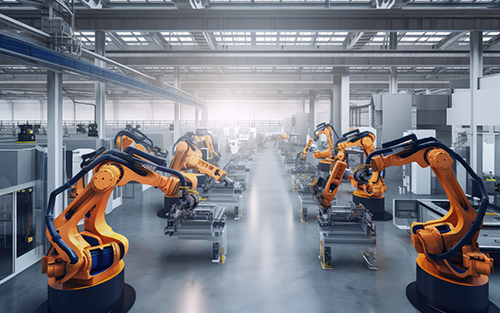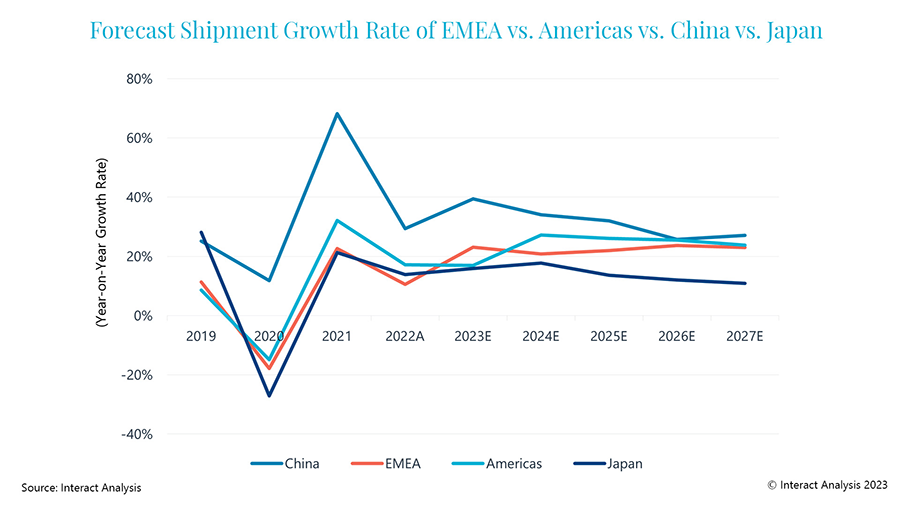- May 22, 2023
- Interact Analysis
- News
Summary
According to updated research by market intelligence firm Interact Analysis, the collaborative robot (cobot) market will enjoy modest growth out to 2032, with annual growth rates sitting at around 20%.

May 16, 2023 - According to updated research by market intelligence firm Interact Analysis, the collaborative robot (cobot) market will enjoy modest growth out to 2032, with annual growth rates sitting at around 20%. "Collaboration" between humans and robots is now widely accepted so robot manufacturers suggest that the key to future success will be their ability to scale up production and develop new application scenarios. The logistics industry will also play an important role in this growth trajectory.

As with all industries, the current economic landscape and the Ukraine-Russia war have had an impact on the collaborative robot market. Out to 2027, shipments of collaborative robots in EMEA will decrease from 19.5% to 15.9%, with a CAGR of 22.4%. However, the CAGR for the Americas region will sit at 25.8%, and at 28.2% in APAC. 2022 and 2023 has, and continues to be, a difficult period for the US and European collaborative robot market as a result of inflation and ongoing supply chain disruptions. Interact Analysis forecasts that EMEA will begin to recover in the second half of 2023 and into the first half of 2024, while recovery in the US will take slightly longer, with a US manufacturing downturn expected in 2024.
The majority of collaborative robot vendors are what Interact Analysis refers to as ‘pure-play’ cobot vendors. This means collaborative robots are their main and only product line. Universal Robots retains its position as market leader, with AUBO, TechMan and JAKA following behind. Most of these vendors are based in the APAC region, with Chinese vendors increasing their share in the local market. South Korean manufacturers have also begun to emerge in the market since 2020, but their success has been largely tied to the local market because market entry is more difficult for overseas manufacturers.
Maya Xiao, research manager at Interact Analysis, commented, “It’s promising to see that the application field for collaborative robots is widening. Maintaining this will be a key factor in future growth of the market. Deployment of cobots in the education, medical, logistics, catering and retail sectors is increasing due to the development of machine vision and machine learning software.”
“The logistics industry also offers enormous opportunity for the collaborative robot market due to the ability of robots to replace manual labor in areas such as picking, packing, loading/unloading and quality inspection. Watch this space, the market is set to enjoy steady growth over the next ten years.”
About the report
Collaborative robots are an important part of intelligent manufacturing and an effective complement to lean production. They’ve enjoyed a spike in popularity over the past few years, benefitting from the push towards automation in industry and constant downward pressure on costs. But which industries will drive growth for collaborative robots in the next five years? What will be the pricing trends as volumes rise? How will collaborative robots complement or influence the traditional industrial robot market? What is the potential for collaborative robots in non-manufacturing fields? This report answers these and other key questions facing the industry today.
About Interact Analysis
With over 200 years of combined experience, Interact Analysis is the market intelligence authority for global supply chain automation. Our research covers the entire automation value chain–from the technology used to automate factory production, through inventory storage and distribution channels, to the transportation of the finished goods. The world’s leading companies trust us to surface robust insights and opportunities for technology-driven growth.
Did you enjoy this great article?
Check out our free e-newsletters to read more great articles..
Subscribe